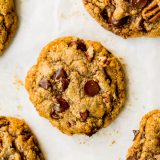In the late 19th century, the availability of cheap white flour and white sugar changed the complexion of desserts. Enough already. It’s time to bring back color and flavor.
I am not going to list the shortcomings of the Toll House chocolate chip cookie. That would be like denouncing the pope at a vespers liturgy in Chartres: not a welcome sentiment. And to be honest, there is timeless charm to the mix of crispy edges, a chewy center and gooey bits of chocolate. I’ve eaten my fair share. I’ve inhaled the cookies as if they were popcorn shrimp. I’m a believer.
Yet, on a visit to Claire Ptak’s Violet bakery in London, I was struck by her use of rye flour in an apricot upside-down cake. This simple substitution—rye for white flour—was a personal revelation.
In most parts of the world, even going back to the medieval kitchen, sweet pairs with savory. There is balance, a give and take. This is what makes sweetness so beguiling. For full effect, it needs a partner that allows it to shine rather than overwhelm. And this is the point of using a flour such as rye. It is slightly bitter and a touch savory.
For those of you who have tried to create your own cookie recipes or have substituted ingredients in existing recipes, you know the horrors that await. Cookies are like cakes to an exponential power: The slightest change in proportions or ingredients alters texture, flavor and appearance. And, to make things even dicier, rye has less gluten than all-purpose flour, so it requires more liquid and bakes up differently. (Complex sugars in rye flour compete with the proteins that create gluten.)
Our first decision was the proportion of rye flour. We decided to go with 1 cup rye to ⅞ cup all-purpose flour. We strongly suggest weighing both flours for best results.
Rye flour comes in medium, light and dark, based on how refined it is. Medium or light rye flour gave us the chewiest texture and the easiest dough to work with. Toasting the flour in a skillet until it was a shade or two darker deepened its flavor. After removing the skillet from the heat, we mixed in 12 tablespoons of butter, which melted in the pan while the flour was still warm.
We whisked this mixture into the sugar, eggs, vanilla and molasses mixture, which helped dissolve the sugar and made the cookies chewier. And melting the butter in the toasted rye helped cool the flour, so we could mix it into the batter without risk of cooking the eggs.
We used a hefty 1½ cups of chocolate chips or chopped dark chocolate; if using the latter, make sure your pieces are not too large or they will melt and overwhelm the cookies. Pecans are optional.
We ended up with a simple recipe—the rye does have to be toasted in a skillet, but this is quick work. The rest is dump and stir. A sweet chocolate chip cookie, to be sure, but one with a more grown-up personality.




